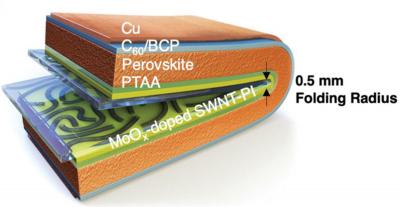Scientists from South Korea have developed a foldable thin-film device with promising characteristics. Integrating a perovskite cell material and a carbon nanotube electrode, the group fabricated a device that achieved 15.2% efficiency and could be folded more than 10,000 times at a bending radius of 0.5mm.

Solar cell materials tend to be quite sensitive. Designing and manufacturing devices that can withstand the stress of being folded and bent is challenging, and many of even the most promising solutions are still quite limited in their flexibility. The scientists at Pusan National University in South Korea took a major step forward in solving this problem, fabricating a device that can be folded down to a 'bending radius' ' the minimum size of fold possible without causing damage ' of 0.5mm.
Key to this performance was the use of single-wall carbon nanotubes (CNTs) as a transparent electrode layer. The CNTs were integrated into a polyimide substrate, which addressed expected problems with CNTs sticking to the substrate as the force was applied. This device was then doped with molybdenum oxide to increase its conductivity. A control device fabricated with a standard ITO electrode and polymer substrate showed severe performance degradation after 1,000 folds at a considerably larger bend radius, and could not withstand even one bend at 0.5mm.
The device achieved 15.2% efficiency, which the group claims is the highest ever achieved for any cell utilizing carbon nanotubes. Though the devices were produced at a small scale using spin-coating techniques, and the group has not investigated possibilities for larger volume processing here, the approach presents solutions to some of the issues that have held back CNT's development for solar applications, and could increase the possibilities for flexible PV in future.



